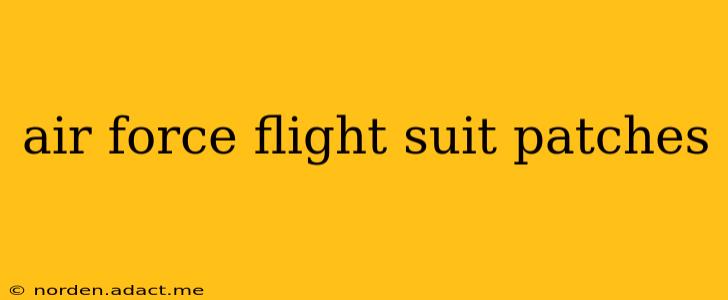For pilots and aircrew, a flight suit is more than just clothing; it's a symbol of service, skill, and identity. And what truly personalizes a flight suit? Patches. These small pieces of fabric tell a story, showcasing a pilot's achievements, affiliations, and even personality. This comprehensive guide delves into the world of Air Force flight suit patches, covering their meaning, placement, regulations, and the rich history behind them.
What Do Air Force Flight Suit Patches Represent?
Air Force flight suit patches serve a multitude of purposes, going beyond simple decoration. They represent:
- Unit Affiliation: Patches often display the insignia of the pilot's assigned unit, squadron, or wing. This instantly identifies the wearer's operational role and command structure. Think of it as a visual representation of their team.
- Aircraft Type: Some patches showcase the specific aircraft flown, like an F-22 Raptor or a C-17 Globemaster III. This signifies the pilot's expertise and experience with a particular aircraft.
- Achievements and Awards: Patches commemorating achievements, qualifications, and awards earned throughout a career are proudly displayed. These might include combat deployments, special certifications, or exceptional performance awards.
- Personalization: While regulations exist, there's still room for personalization. Pilots might include patches reflecting personal interests, hobbies, or even humorous nods to inside jokes within their unit. However, it's important to maintain professionalism.
Where Are Patches Placed on an Air Force Flight Suit?
The placement of patches on an Air Force flight suit isn't random; it follows established guidelines. Common locations include:
- Upper Arms: Unit patches are usually placed on the upper arms. The left arm often features the pilot's primary unit, while the right might display a secondary unit or a specialized training patch.
- Chest: The chest area is often reserved for achievement and award patches, arranged according to specific regulations and precedence.
- Name Tape: Above the left breast pocket, the name tape clearly identifies the wearer. This is a crucial identification element and part of the uniform's overall design.
- Rank Insignia: Rank insignia are prominently displayed on the flight suit, usually on the shoulders or sleeves, depending on the specific Air Force uniform.
- National Insignia: The U.S. Air Force flag or national insignia is often found on the left breast, showing pride in national service.
What Are the Regulations Regarding Air Force Flight Suit Patches?
While pilots are allowed to express their individuality through patch selection, regulations strictly govern their placement, size, and appropriateness. These regulations ensure uniformity and professionalism while maintaining a sense of individual identity. Detailed regulations are specified in Air Force Instruction (AFI) manuals and are subject to change, so keeping updated is crucial.
What Types of Air Force Flight Suit Patches Exist?
The variety is vast! Here are some common types:
- Unit Patches: These display the emblem or insignia of a specific unit, squadron, or wing.
- Aircraft Patches: These patches feature the image or name of a particular aircraft the pilot has qualified to fly.
- Mission Patches: These are often commemorative patches marking specific deployments or missions.
- Qualification Patches: These signify the pilot's completion of specialized training or qualifications.
- Award Patches: These represent achievements and awards received during a career.
How Are Air Force Flight Suit Patches Made?
Air Force flight suit patches are typically embroidered or woven, ensuring durability and longevity in the harsh conditions pilots often face. High-quality materials and precise craftsmanship ensure they withstand daily wear and tear.
Where Can I Find Information on Specific Air Force Flight Suit Patch Designs and Meanings?
For detailed information on specific patch designs and their associated meanings, the best resources would be Air Force unit websites or museums dedicated to Air Force history.
What are some common misconceptions about Air Force Flight Suit Patches?
One common misconception is that any patch can be worn. Regulations govern which patches are authorized, their placement, and size, so adhering to these guidelines is critical. Another misconception is that a flight suit patch immediately shows a pilot's skill level. While some patches reflect qualifications, skill is often determined by experience and performance assessments.
This guide offers a solid foundation in understanding the significance and regulations surrounding Air Force flight suit patches. Remember, these aren't mere decorations but powerful symbols of service, skill, and identity. They tell a compelling story of dedication and commitment to the Air Force mission.
